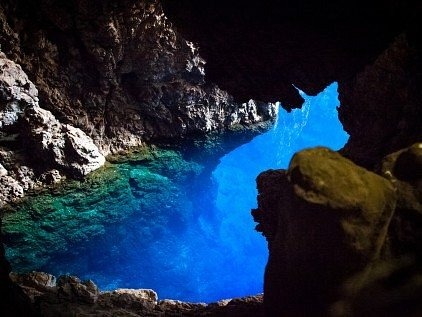Exploring Chinhoyi Caves: Legends, Myths, and Mysteries
8/22/20257 min leer


Introduction to Chinhoyi Caves
The Chinhoyi Caves, an extraordinary natural formation located in Zimbabwe, are renowned for their breathtaking beauty and geological significance. Situated approximately 120 kilometers northwest of Harare, these caves serve as a remarkable example of limestone karst topography. The caves are a vital component of the ecological landscape, attracting visitors from around the world who are intrigued by their unique features and historical narratives.
Historically, the Chinhoyi Caves have been important to the local community, serving various cultural and spiritual purposes over generations. The caves were previously known as “Chirorodziva” by the local Shona people, which translates to “the place of the spirits.” This designation reflects the deep-rooted legends and ancestral beliefs associated with the site. According to local folklore, the caves are linked to intriguing tales of lost treasure and ancient guardians, which adds an element of mystique to their allure.
In recognition of their natural significance and cultural heritage, the Chinhoyi Caves were declared a national monument in 1955. This designation was not only to preserve the caves for future generations but also to highlight their importance as a tourist destination. The complex consists of several chambers, the most notable being the Underground Lake, known for its stunning crystal-clear blue waters that seem to glow under the surface. These waters, with depths reaching 50 meters, contribute significantly to the caves' popularity, as they are ideal for diving and exploring the submerged formations.
The limestone formations within the caves exhibit unique geological patterns shaped by millions of years of erosion and chemical processes. These formations present a fascinating topic for geological study and draw researchers and enthusiasts alike. Additionally, the surrounding area is rich with biodiversity, housing various flora and fauna endemic to this region. The Chinhoyi Caves truly encapsulate a blend of natural wonder and cultural significance, making them a pivotal attraction in Zimbabwe.
Geological Formation of Chinhoyi Caves
The Chinhoyi Caves, located in Zimbabwe, offer an intriguing glimpse into the Earth's geological history, characterized by their distinct limestone formations. These caves were formed over millions of years through a natural process known as chemical weathering. The primary rock type present in the caves is limestone, which originated from the remains of marine organisms that deposited in shallow seas approximately 100 million years ago. This limestone has undergone extensive transformations due to both geological pressure and the erosive action of water over vast periods.
The process of cave formation began when slightly acidic rainwater percolated through the soil and seeped into the limestone bedrock. As this water moved through the rock, it gradually dissolved the limestone, creating intricate passages and chambers. This phenomenon is known as karren, which refers to the unique surface features formed as a result of dissolution. These elongated voids eventually resulted in the formation of an expansive subterranean system, making the Chinhoyi Caves a remarkable geological site.
Besides the captivating geological structures, the surrounding ecosystem of the Chinhoyi Caves has developed into a vibrant habitat. The moisture and unique microclimates created by the caves support various flora and fauna, contributing to the biodiversity of the area. Species of bats are often found inhabiting the caves, playing vital roles in the local ecosystem by assisting in pest control and pollination. Additionally, some endemic plant species have been documented in the vicinity, underscoring the region's ecological significance.
The Chinhoyi Caves stand as a testament to the powerful forces of nature that have shaped their existence. Their complex geological features and rich biodiversity offer valuable insights into various natural processes, making them a subject of interest for geologists and nature enthusiasts alike.
History and Cultural Significance
The Chinhoyi Caves, located in Zimbabwe, represent a site of remarkable historical and cultural importance that spans several centuries. These captivating geological formations are not mere tourist attractions; they have been integral to the local communities long before they were rediscovered by modern explorers. Archaeological evidence suggests that human activity in the region dates back thousands of years, with indigenous groups utilizing the caves for shelter and spiritual practices.
Historically, the caves served as a refuge for various tribes, particularly during conflict periods when safety and seclusion were paramount. The Shona people, one of the primary ethnic groups in the region, regard these caves as a sacred site, entwined with their cultural beliefs. Legends narrate that the caves were home to mystical creatures and spirits, which have woven themselves into the fabric of local folklore. Such narratives are not only vital for cultural identity but also help sustain the oral traditions of the indigenous communities.
Furthermore, the caves have been associated with various local events and rituals, marking significant milestones in the lives of these communities. Specific areas within the caves are deemed especially sacred, where traditional ceremonies and offerings take place, reinforcing a connection between the natural world and spiritual beliefs. Over the years, the cultural significance of the Chinhoyi Caves has been recognized through various conservation efforts, aiming to preserve both the geological wonders and the rich history embedded within them.
Modern visitors are not only drawn to the striking beauty of the Chinhoyi Caves but also to the profound stories they encapsulate. By exploring these depths, one can gain insight into the rich tapestry of human activity that has characterized this area over the centuries, highlighting the interplay between nature, culture, and spirituality.
Myths and Legends Surrounding the Chinhoyi Caves
The Chinhoyi Caves, a prominent natural wonder in Zimbabwe, are steeped in captivating myths and legends that have been integral to the local culture for generations. According to various tales, these caves are not merely geological formations but gateways to the spiritual realm. One of the most famous legends tells of a mystical spirit known as the "Mudzimu," believed to guard the caves and its hidden treasures. Locals recount how those who disrespect the enigmatic spirit often find themselves lost within the labyrinthine passages of the caves, unable to escape until they seek forgiveness.
Another tale speaks of a lost treasure, rumored to be hidden within the depths of the caves. This treasure, said to belong to an ancient tribe, has lured adventurers and treasure seekers for years. The locals warn that the treasures lay protected by supernatural forces, and many who have attempted to locate them have reported strange occurrences, further enhancing the caves' mystical reputation. These stories also serve a practical purpose; they instill respect for the natural surroundings and caution against meddling with what is deemed sacred.
Exploration and Tourism at Chinhoyi Caves
Chinhoyi Caves, known for their stunning rock formations and captivating legends, have gained prominence as a significant tourist destination in Zimbabwe. Located approximately 120 kilometers from Harare, these caves offer visitors a unique experience of natural beauty intertwined with cultural narratives. The exploration of Chinhoyi Caves is facilitated by a variety of organized tours that provide insights into the caves' extensive history and geological features. Professional guides are available to lead groups through the labyrinthine sections of the caves, enhancing the exploration with stories of the local folklore and myths that envelop these ancient formations.
Tourism at Chinhoyi Caves is not limited to the cave tours alone. The surrounding area features picnic sites, hiking trails, and viewing platforms that allow guests to appreciate the natural landscape. The recreational opportunities attract both adventure seekers and those who prefer leisurely exploration. Visitors can engage in swimming in the nearby Blue Pool, a striking water body within the caves, renowned for its vivid blue color and depth. This alluring site draws not only thrill-seekers but also families and nature enthusiasts who wish to enjoy the serene environment.
As tourism continues to develop in the region, there is an increasing emphasis on sustainable practices to preserve the pristine beauty and mythic essence of the caves. Stakeholders are working towards promoting eco-friendly tourism experiences that minimize environmental impact while maximizing visitor satisfaction. Educational initiatives aim to raise awareness among tourists about the significance of protecting these natural wonders for future generations. By promoting responsible tourism, Chinhoyi Caves can continue to be a place of wonder, where legends come alive amid breathtaking geological formations.
The Scientific Study of Chinhoyi Caves
The Chinhoyi Caves, located in Zimbabwe, are not only steeped in myth and legend but are also the focus of scientific study that aims to unravel their geological and archaeological significance. Researchers have been investigating the unique geological formations present within the caves, which are primarily composed of limestone. Over thousands of years, natural processes such as erosion and the dissolution of rock have shaped striking features like stalactites and stalagmites, providing insights into historical environmental conditions.
In addition to geological features, the caves are a potential site for archaeological discoveries. Studies have suggested that humans may have inhabited this region long before recorded history. Investigations into the presence of artifacts, as well as remnants of ancient settlements, could offer valuable data related to the cultural practices of past civilizations. Archaeological methods employed in this research, including carbon dating and stratigraphy, are crucial in establishing a timeline of human activity in and around the caves.
Environmental assessments conducted in recent years have also contributed to our understanding of the Chinhoyi Caves' ecosystem. Researchers evaluate the cave's microclimate and its impact on endemic species of flora and fauna. Biologists are particularly interested in documenting unique microorganisms that thrive in this subterranean habitat, which could provide insight into biodiversity and ecosystem resilience.
Furthermore, scientific inquiry into the Chinhoyi Caves can challenge or enhance the existing myths surrounding them. By providing evidence-based explanations for phenomena historically attributed to supernatural forces, researchers can bridge the gap between folklore and factual understanding. This interplay between science and legend not only enriches our knowledge but also reflects the importance of preserving both natural and cultural heritage.
Conclusion: The Enigma of Chinhoyi Caves
Chinhoyi Caves stand as a striking testament to the beauty and mystery of Zimbabwe's natural landscapes. Throughout this exploration, we have delved into the legends, myths, and cultural significance that envelop these caves. The striking blue waters of the Sleeping Pool and the intricate limestone formations not only captivate the eye but also serve as conduits for rich folklore and historical narratives. Each anecdote, whether it pertains to local tribes or early explorers, weaves a tapestry of stories that enhances the understanding of the caves as more than mere geological formations.
The caves also play a pivotal role in local heritage, bridging the past with the present. As we reflect on the legends associated with Chinhoyi Caves, it becomes clear that these natural wonders are imbued with significance that transcends their physical beauty. They are places where history and myth converge, creating a sense of identity and continuity for the communities that surround them. The cultural narratives linked to these caves speak volumes about the relationship between the environment and the people who inhabit it, underscoring the importance of conserving such sites.
Moreover, the enigma of Chinhoyi Caves invites visitors to engage not just with their breathtaking aesthetics but with the profound stories they embody. By appreciating both the visual splendor and the tales that echo through the cavernous corridors, we recognize the potential these sites hold in fostering a deeper understanding of cultural heritage and environmental significance. As stewards of our natural and cultural resources, it is imperative that we preserve and celebrate these incredible locations for future generations to explore, learn, and appreciate the legends that forever hold them in a shroud of mystery.
